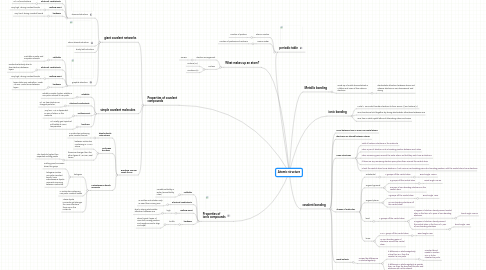
1. periodic table
1.1. atomic number
1.1.1. number of protons
1.2. mass number
1.2.1. number of protons and neutrons
2. What makes up an atom?
2.1. electron arrangement
2.1.1. 2,8,8,8
2.2. nucleus
2.2.1. Protons (P+)
2.2.2. Neutrons (n)
3. Properties of ionic compounds
3.1. solubility
3.1.1. variable solubility in water (see solubility rules)
3.2. electrical conductivity
3.2.1. as molten and solution only as need free moving ions
3.3. melting point
3.3.1. high
3.3.1.1. due to strong electrostatic attraction between ions
3.4. hardness
3.4.1. brittle
3.4.1.1. when forced, layers of ions shift causing positive and negative ions to align and repel.
4. Properties of covalent compounds
4.1. giant covalent networks
4.1.1. diamond structure
4.1.1.1. solubility
4.1.1.1.1. insoluble in water and non polar substances
4.1.1.2. electrical conductivity
4.1.1.2.1. nil, no free electrons
4.1.1.3. melting point
4.1.1.3.1. very high -strong covalent bonds
4.1.1.4. hardness
4.1.1.4.1. very hard- strong covalent bonds
4.1.2. silicon dioxide structure
4.1.3. bucky balls structure
4.1.4. graphite structure
4.1.4.1. solubility
4.1.4.1.1. insoluble in water and nonpolar solvents
4.1.4.2. electrical conductivity
4.1.4.2.1. conducts electricity due to free electrons between layers
4.1.4.3. melting point
4.1.4.3.1. very high- strong covalent bonds
4.1.4.4. hardness
4.1.4.4.1. layers slide over eachother - weak Van Der Waals forces between layers
4.2. simple covalent molecules
4.2.1. solubility
4.2.1.1. soluble in water if polar, soluble in non-polar solvents if non-polar
4.2.2. electrical conductivity
4.2.2.1. nil- no free electrons or charged particles
4.2.3. melting point
4.2.3.1. Very low - MP is dependant on size of atoms in the molecule
4.2.4. hardness
4.2.4.1. nil, mostly gas, liquids of soft solids at room temperature
4.3. Breaking Van Der Waals forces
4.3.1. dipole-dipole interactions
4.3.1.1. in molecules containing polar covalent bonds
4.3.2. Hydrogen bonding
4.3.2.1. between molecules containing O, H or F atoms
4.3.2.2. these are stronger than the other types of Van Der Waal forces
4.3.2.2.1. This leads to higher than expected melting points
4.3.3. instantaneous dipole moments
4.3.3.1. halogens
4.3.3.1.1. melting point increases down the group
4.3.3.1.2. halogens contain non-polar covalent bonds have instantaneous dipole moments occurring between molecules.
4.3.3.2. in molecules containing non-polar covalent bonds
4.3.3.3. These dipole moments get stronger the more electrons there are in the molecule
5. ionic bonding
5.1. Metal + non-metal transfer electrons to from anions (-) and cations (+)
5.2. Ionic bonds are held together by strong electrostatic attractions between ions
5.3. Ions from a solid crystal lattice of alternating cation and anion
6. covalent bonding
6.1. Form between two or more non-metal atoms
6.2. Electrons are shared between atoms
6.3. Lewis structures
6.3.1. Total all valence electrons in the molecule
6.3.2. Place a pair of electrons into a bonding position between each atom
6.3.3. Place remaining pairs around the outer atoms so that they each have 8 electrons
6.3.4. If there are any remaining electron pairs place them around the central atom
6.3.5. Check the central atom has 8 electrons. If not move a non-bonding pair into a bonding position until the central atom has 8 electrons
6.4. Shapes of molecules
6.4.1. Tetrahedral
6.4.1.1. 4 groups off the central atom
6.4.1.1.1. Bond angle 109.5o
6.4.2. Trigonal pyramid
6.4.2.1. 3 groups off the central atom
6.4.2.1.1. Bond angle 109.5o
6.4.2.2. one pair of non-bonding electrons on the central atom
6.4.3. Trigonal planar
6.4.3.1. 3 groups off the central atom
6.4.3.1.1. Bond angle 120o
6.4.3.2. no non-bonding electrons off the central atom
6.4.4. bent
6.4.4.1. 2 groups off the central atom
6.4.4.1.1. 4 regions of electron density around central atom in the form of 2 pairs of non-bonding electrons
6.4.4.1.2. 3 regions of electron density around the central atom in the form of 1 pair of non-bonding electrons
6.4.5. linear
6.4.5.1. 2 or 1 group off the central atom
6.4.5.1.1. Bond angle 180o
6.4.5.2. no non-bonding pairs of electrons around the central atom.
6.5. Bond polarity
6.5.1. Caused by differences in electronegativity
6.5.1.1. If difference in electronegativity is less than 0.5, then the covalent is non-polar
6.5.1.1.1. Covalent bond needs to contain F,O, N to be classified as polar
6.5.1.2. If difference in electrnegativity is greater than 4.0, then the bond will be ionic and electrons will not be shared.
6.6. Polar covalent molecules
6.6.1. occur when the bond polarities do not cancel.
6.6.1.1. when polar bonds are in the same plane, the the polarities will cancel eg in SO3. This is non-polar
7. Metallic bonding
7.1. made up of metal atoms stacked in a lattice and a sea of free valence electrons
7.1.1. electrostatic attraction between atoms and valence electrons is non dimensional and strong
